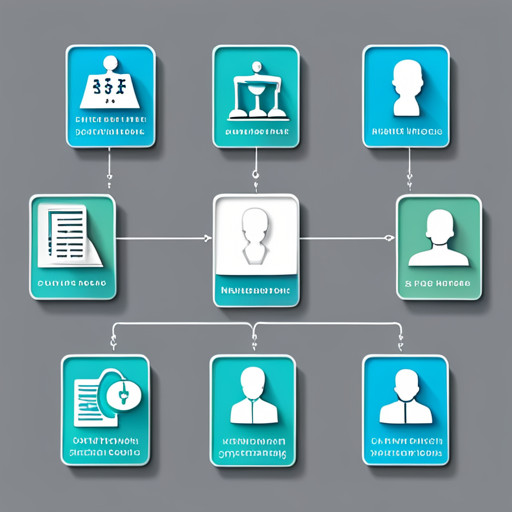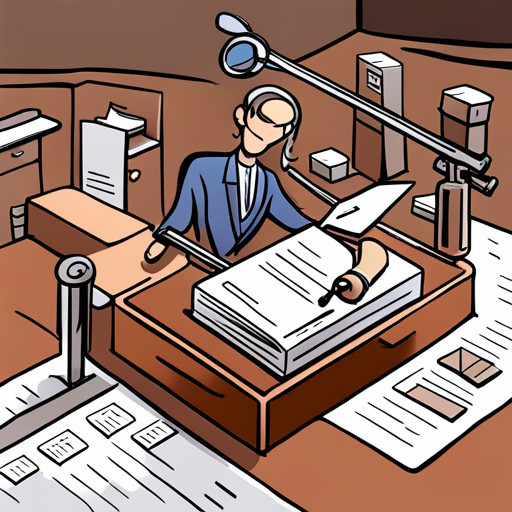9 Key Steps of the Small Claims Court Process for a Personal Injury Case
How does one navigate the complexities of the small claims court process in a personal injury case?

This article elucidates nine crucial steps in the journey, from understanding the process and identifying the correct party to sue, through to the nuanced aspects of trial preparation and presentation.
The aim is to provide a structured, detailed guide to support individuals in effectively managing their small claims personal injury cases.
Key Takeaways
- Importance of exhausting all other possibilities for compensation before filing a lawsuit
- Determining the correct party to sue, including liability on leased properties and absence of an insurance company
- Understanding the concept of venue and court jurisdiction, and filing the lawsuit in the appropriate county
- Organizing trial evidence effectively, including police reports, medical records, and photographs
Understanding the Small Claims Court Process

In the process of pursuing a personal injury case through small claims court, it is critical to understand the importance of exhausting all other avenues for compensation. This means exploring options such as insurance claims or settlement negotiations before resorting to a lawsuit. By doing so, it may lead to a quicker and more amicable resolution.
Another crucial aspect is ascertaining the value of the claim. Knowing the worth of your claim can guide decisions, especially when the claim exceeds the small claims court limit. This information can help you determine whether it is more appropriate to pursue the case in a higher court or if small claims court is the best option.
It is also important to comprehend the variations in small claims court limits and names by state. Each state may have different limits on the amount of money that can be sought in small claims court, as well as different names for the court itself. Understanding these variations is essential in setting realistic expectations and avoiding procedural errors.
Lastly, considering the statute of limitations is vital in pursuing a personal injury case through small claims court. The statute of limitations refers to the time limit within which a lawsuit must be filed. Missing this deadline can result in the loss of the right to sue. Therefore, it is crucial to be aware of the statute of limitations and ensure that the lawsuit is filed within the specified timeframe.
Determining the Correct Party to Sue

Identifying the party responsible for the damage or injury is a crucial aspect of initiating a lawsuit. An investigation into the incident often reveals liability considerations that can influence the decision of whom to sue. For instance, in instances where damage is caused on leased properties, the liability might fall on the owner or the leaseholder, depending on the lease agreement. Insurance coverage also plays a significant role in determining the party to sue.
| Liability Considerations | Insurance Coverage |
|---|---|
| Lease agreements | Coverage of the incident |
| Legal obligations of parties involved | Defendant's insurance policy |
| State laws and regulations | Uninsured defendant scenarios |
These considerations are pivotal in the identification of the correct party to sue in a personal injury case. Thus, a detailed understanding of both liability and insurance aspects is vital.
Confirming the Correct Venue

Determining the appropriate venue for filing a lawsuit is a crucial consideration, often guided by jurisdictional rules and the location of the incident or the defendant. The importance of researching jurisdiction cannot be overstated as it determines the court's ability to hear the case.
1. Jurisdiction Research: This involves understanding the court's geographical area and subject matter competence. A thorough comprehension of these factors is critical in selecting the proper venue.
2. Venue Identification: This requires locating the county where the defendant resides or where the incident occurred. This is facilitated by online resources or the local county clerk's office.
3. Venue Confirmation: This step ensures that the chosen venue is indeed the correct one, preventing potential dismissal of the case.
This process underscores the importance of locating the proper venue in a personal injury lawsuit.
Properly Filing Your Small Claims Lawsuit

Submission of the lawsuit to the appropriate county is a critical phase, necessitating precision in completing the complaint form, payment of the filing fee, and proper service of the defendant with notification of the lawsuit. Adherence to the filing requirements is fundamental, with each county having specific guidelines to be followed. The filing fees, which vary by jurisdiction, should be paid promptly to avoid delays in processing the lawsuit. Once these steps are meticulously completed, the defendant must be served with a copy of the lawsuit, adhering to the procedures prescribed by the court.
| Step | Requirement | Importance |
| 1 | Completing the complaint form | Precision is necessary to avoid errors |
| 2 | Paying the filing fees | Prompt payment ensures smooth processing |
| 3 | Serving the defendant | Adherence to court-proscribed procedures is critical |
| 4 | Abiding by county-specific guidelines | Each jurisdiction may have unique requirements |
Organizing Trial Evidence

Comprehension of the evidentiary elements, such as police reports and medical records, plays a crucial role in the organization of trial evidence. This meticulous organization helps in presenting the case in a clear, concise manner.
The following three steps guide the process:
1. Understanding Evidence: The first step involves familiarizing oneself with the nature of evidence, primarily medical records and police reports. This includes understanding relevant medical terminology and the contents of police reports.
2. Preparation of Evidence: The second step necessitates preparing and collating all evidence. This may involve photographs, wage verification letters, and receipts.
3. Organization of Evidence: The final step is the systematic organization of all evidence in a trial folder. This not only aids in presenting the case efficiently but also maximizes the impact of the evidence.
Preparing a Trial Folder

Effective organization of evidence into a trial folder facilitates a smooth presentation during the lawsuit, ensuring each piece of evidence is easily accessible and distractions are minimized.
A well-structured trial folder often forms the backbone of an effective trial strategy, guiding the progress of the case and providing a clear road map for the presentation of evidence.
This process involves classifying each piece of evidence for quick reference and creating an index for each section of the folder.
Gathering witness testimonies is another crucial component of this stage. These testimonies should be carefully documented and included in the trial folder.
In this way, a meticulously prepared trial folder can maximize the impact of the evidence, thus enhancing the efficiency and effectiveness of the overall trial strategy.
Planning for Trial

Planning for trial involves strategic organization of evidence, creation of an index for each section of the folder, and thorough preparation of arguments to be presented in court. This process is vital for developing effective arguments. It includes several stages, such as evidence gathering, document classification, and argument formulation.
1. Evidence Gathering: This phase emphasizes the meticulous collection of pertinent evidence, ensuring all relevant details are included to support the case.
2. Document Classification: Each piece of evidence is categorized and indexed in the trial folder, facilitating quick and easy access during trial.
3. Argument Formulation: This stage involves the careful crafting of arguments and strategies for cross examination. Preparation includes understanding the opposition's probable counter-arguments and framing responses accordingly.
These measures collectively aid in presenting a compelling case in court.
Practice and Presentation

Transitioning from planning for a trial, the process advances to the stage of practice and presentation. This phase involves the meticulous crafting of arguments to be delivered during the court proceedings. The task necessitates a clear, concise, and compelling manner of writing arguments, which should encompass all relevant evidence.
Moreover, this stage also requires rehearsing the presentation and closing statement vocally to ensure their effective delivery. Of equal importance is the aspect of dressing appropriately for the court appearance. A professional attire contributes to the overall impression of seriousness and respect for the court proceedings, thus, should not be overlooked.
This stage, therefore, emphasizes the significance of both well-presented arguments and appropriate court decorum.
Presenting Your Case in Court

In the proceedings of presenting the lawsuit within the designated venue, it becomes essential to comprehend that venues such as these are structured specifically for individuals who are not professional lawyers. A thorough understanding of courtroom etiquette is crucial, as it contributes to the overall presentation of the case. Additionally, cross-examination strategies can make or break a case.
1. Courtroom Etiquette: Respect for the court and its procedures is vital. This includes addressing the judge correctly, speaking only when asked, and dressing appropriately.
2. Cross Examination Strategies: Evidence should be presented logically and systematically. Aiming to undermine the credibility of the defendant's statements can also be beneficial.
3. Presentation: Stay focused on the facts and try to remain composed, despite the pressure of the situation.
Frequently Asked Questions
What Should I Do if the Defendant Countersues in a Small Claims Court?”
If faced with a counterclaim during the small claims court process, strategic actions must be undertaken. This involves understanding counterclaim defenses and preparing counterarguments.
It is essential to gather relevant evidence that refutes the defendant's claims. This may require re-examining all documents, photographs, and witness testimonies.
Legal advice may be beneficial to navigate this complex process. Ultimately, the plaintiff's aim is to demonstrate the weakness or irrelevance of the counterclaim to the court.
Are There Any Special Considerations if I’m Filing a Small Claims Lawsuit Against a Business Rather Than an Individual?”
When filing a small claims lawsuit against a business instead of an individual, two primary considerations emerge: business liability and documentation requirements.
Business liability involves identifying the correct legal entity to sue, which can be complex due to corporate structures.
Documentation requirements may also increase, necessitating evidence of the business's liability.
It is crucial to understand these elements for a successful claim against a business entity.
Can I Appeal the Decision if I Lose My Small Claims Lawsuit?”
In the context of a small claims lawsuit, an appeal may be possible depending on jurisdictional rules. Grounds for appeal generally require identification of a legal error that significantly impacted the case's outcome.
Legal representation can be beneficial in the appeal process, although the accessibility of small claims court often allows individuals to represent themselves.
It is crucial to note that appealing a decision can extend the legal process significantly.
What Are the Potential Consequences if I Miss a Court Date for My Small Claims Case?”
Missing a court date in a small claims case can result in severe consequences, including the court ruling in favor of the opponent by default. This is known as a default judgment. The court may also impose fines or issue a warrant for arrest due to contempt of court.
Mitigating these consequences may necessitate a valid reason for the absence and immediate contact with the court to reschedule the missed hearing.
What Options Do I Have if the Defendant Does Not Pay the Judgment After Losing the Small Claims Case?”
When the defendant fails to pay the judgment following a small claims case, various collection strategies can be employed to enforce judgements. These include wage garnishment, property liens, or bank account levies.
The court does not collect the money, but it provides mechanisms to facilitate the process.
It's not a walk in the park, but with the appropriate legal tools and persistence, plaintiffs can often recover the awarded amounts.

This post has been generated by AI and was not reviewed by editors. This is Not legal advice. Please consult with an attorney.




